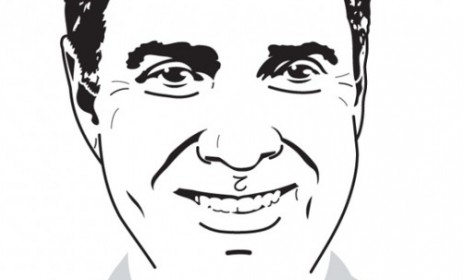Everything you need to know about palliative care
It's the best solution for people facing serious, painful diseases, and introduces the very real possibility of living comfortably with such diseases for a very long time

The toughest issue in life is dealing with poor health. The dreaded diagnosis of a loved one or friend, a family member, or even yourself. As a doctor, especially a transplant surgeon, you face serious illness every day.
But a brand new field in medicine is making chronic, agonizing, and even terminal illnesses much more manageable. Most people don't know anything about it. But with the miraculous advances we are making in treating cancer and heart disease, palliative care has emerged as the best solution for those facing serious, painful diseases, and introduces the very real possibility, thanks to modern medicine, that we can now live with these diseases for a long time.
Despite this, confusion and trepidation linger. From patients and families to health-care professionals and cost control experts, I get the same questions over and over. To help clear up confusion about a topic I believe will be revolutionary, I'd like to clarify a few major points. Pay attention. If you have an aging family member, are concerned about the exploding national debt and rapidly rising health-care prices, or simply just smartly looking ahead, this topic will impact your life.
Subscribe to The Week
Escape your echo chamber. Get the facts behind the news, plus analysis from multiple perspectives.

Sign up for The Week's Free Newsletters
From our morning news briefing to a weekly Good News Newsletter, get the best of The Week delivered directly to your inbox.
From our morning news briefing to a weekly Good News Newsletter, get the best of The Week delivered directly to your inbox.
What is palliative care?
Palliative care is personalized medical care provided for individuals with serious and life-threatening illnesses and, very importantly, for their families. With a focus on relieving symptoms, pain, and stress, the primary goal is to provide comfort, relief, and increased quality of life for the patient and family. It isn't hospice and it isn't traditional end-of-life care.
In practice, a team of doctors and care professionals work together to comprehensively address all the needs of the individual patient. It is a real team. Doctors, nurses, home care specialists, social workers, massage therapists, pharmacists, nutritionists, psychiatrists, and chaplains all work in a coordinated, thoughtfully integrated fashion to manage the patient. Importantly, the patient and his or her family are at the heart of developing the care plan every step of the way.
This means you get expert, individualized care in managing pain and any other aggravating symptoms like fatigue, insomnia, and depression. Even seemingly minor things like help with transportation or having a pastor with you before and after surgery are all part of palliative care. You are guaranteed close communication with each team member, help navigating the tricky health-care maze, sensitive guidance in choosing among increasingly complex treatment choices, and strong emotional and spiritual support along the way. Your goals, clearly defined, drive this process.
Sign up for Today's Best Articles in your inbox
A free daily email with the biggest news stories of the day – and the best features from TheWeek.com
Is palliative care simply hospice with a new name?
No. Hospice care is limited, by law, to easing the last few months of a patient's life, when death is certain and immediate. Hospice is powerful and positive, and patients and families usually say they wish they had known about it earlier. Palliative care, in contrast, applies to ALL stages of chronic or serious disease, whether you have a reasonable shot at a cure, or will live with your diagnosis as a chronic problem for many years. Unlike hospice, it is frequently combined with curative therapies like chemotherapy or surgery.
The patient and his or her family are at the heart of developing the care plan every step of the way.
Palliative care makes the patient stronger and often more able to tolerate additional medical treatments. The team-based approach ensures a complete range of treatment options tailored to your individual needs at every point in time. Some patients get so much better that they no longer need the palliative care team. Others with chronic conditions — chronic lung disease (COPD), for instance — might move in and out of palliative care as needed.
How will I benefit?
The main benefit of palliative care is increased quality of life for the patient and his or her family. So what does that mean? It means a stronger person who is more active and can manage more activities for herself. It means less pain, nausea, fatigue, loss of appetite, difficulty sleeping, and depression.
It means a family that is listened to and helped every step of the way. It means more time spent at home with friends and family, and less time spent in the intensive care unit (ICU), isolated and hooked up to a battery of machines.
It means higher patient satisfaction.
The Journal of the American Medical Association published a survey detailing the lack of family satisfaction with hospitals as the last place of care. Over three quarters of respondents did not have enough contact with their doctors during this painful, nerve-wracking time, and half were unsatisfied with the emotional support given to both the patient and other family members. Beyond emotional support, family caregivers often need help with more practical activities like transportation, medication refills, or homemaking, all of which palliative care helps provide. Almost every study on the issue ranks palliative care higher in patient and family satisfaction than the usual hospital a la carte approach.
How many palliative care doctors are there?
Palliative care is a new field, emerging over just the last decade. Currently, more than 1,650 hospital palliative care programs exist in the U.S., according to Dr. Diane Meier, director of the Center to Advance Palliative Care at Mount Sinai School of Medicine in New York City. About 85 percent of large hospitals with more than 300 beds have a palliative care team. Among smaller hospitals with more than 50 beds, about 67 percent have programs.
Thankfully, palliative care is quickly expanding. Currently, palliative programs reach 1.5 percent to 2 percent of all hospital discharges (the goal is 8-10 percent of hospital discharges, as this number represents the sick and complex patients who can most benefit from palliative care). The percentage of patients served will only grow as palliative care teams expand their reach to outpatient settings, doctors' offices, cancer centers, community home care, and emergency departments.
But we still have a shortage. A 2010 Journal of Pain and Symptom Management study suggests that America needs an additional 6,000 to 18,000 new specialists to staff existing facilities and grow the field. This doesn't even include faculty needed to teach this new model and researchers to expand the field's evidence base.
Is palliative care expensive?
No. In fact, it saves money by keeping patients and their families comfortable and in control of their lives. A patient who has well-controlled symptoms and knows where she can call to get reliable and immediate help in an emergency situation does not end up the emergency room or hospital. Most hospitalizations occur precisely because of uncontrolled symptoms and exhausted, overwhelmed family caregivers trying their best at home who have nowhere else to turn. Thus palliative care teams result in smarter, less-wasteful use of resources.
This may seem counterintuitive. How does a system that uses the services of such a skilled team of professionals actually reduce costs? The savings occur mainly in keeping patients in control and comfortable and therefore able to stay out of the costly hospital and especially the ICU. Every day in an ICU can cost $10,000. By more comfortably, more safely, and more appropriately supporting patients and families in the out-of-hospital home environment, huge savings are accrued. Studies, including those in Health Affairs and Archives of Internal Medicine, have repeatedly shown this to be a reality.
Palliative care typically centers on patients who are extraordinarily expensive. Ten percent of Medicare patients alone, mostly with multiple chronic conditions, account for more than 60 percent of the total cost of the program. These very same people — the chronically ill, the dual eligibles, and those in their last year of life — are those who have the most to gain from palliative care. Most don't know about it.
In the current health care delivery reform environment, palliative care will play an increasingly visible and important role. It will be central in the new wave of integrated Accountable Care Organizations (ACOs) and population-based reimbursement models that are being explored now. Programs that are designed to provide seamless care, from the beginning of an illness to the end, will increasingly rely on the expertise and person-centered approach of palliative care teams.
Does palliative care extend life?
Preliminary findings strongly suggest that palliative care contributes to longer life. This is because better quality of life and prevention of severe disabling pain and other symptoms lead to reduced rates of depression and more patient activity. Coordinated care and support for families leads to less need for hospital and ICU stays where patients are subjected to a wide array of hospital risks like infections and medical errors. Combined with the increased support for family caregivers and patients at home, palliative care positively impacts your health in myriad ways.
This was shown clearly in the New England Journal of Medicine in a recent randomized trial of newly diagnosed lung-cancer patients. Those receiving palliative care combined with the best cancer treatment lived almost three months longer than those getting the best cancer treatment alone. These patients also experienced a better quality of life, less depression, and spent less time in the hospital.
-
 The JFK files: the truth at last?
The JFK files: the truth at last?In The Spotlight More than 64,000 previously classified documents relating the 1963 assassination of John F. Kennedy have been released by the Trump administration
-
 'Seriously, not literally': how should the world take Donald Trump?
'Seriously, not literally': how should the world take Donald Trump?Today's big question White House rhetoric and reality look likely to become increasingly blurred
-
 Will Trump's 'madman' strategy pay off?
Will Trump's 'madman' strategy pay off?Today's Big Question Incoming US president likes to seem unpredictable but, this time round, world leaders could be wise to his playbook
-
 Democrats vs. Republicans: who are the billionaires backing?
Democrats vs. Republicans: who are the billionaires backing?The Explainer Younger tech titans join 'boys' club throwing money and support' behind President Trump, while older plutocrats quietly rebuke new administration
-
 US election: where things stand with one week to go
US election: where things stand with one week to goThe Explainer Harris' lead in the polls has been narrowing in Trump's favour, but her campaign remains 'cautiously optimistic'
-
 Is Trump okay?
Is Trump okay?Today's Big Question Former president's mental fitness and alleged cognitive decline firmly back in the spotlight after 'bizarre' town hall event
-
 The life and times of Kamala Harris
The life and times of Kamala HarrisThe Explainer The vice-president is narrowly leading the race to become the next US president. How did she get to where she is now?
-
 Will 'weirdly civil' VP debate move dial in US election?
Will 'weirdly civil' VP debate move dial in US election?Today's Big Question 'Diametrically opposed' candidates showed 'a lot of commonality' on some issues, but offered competing visions for America's future and democracy


